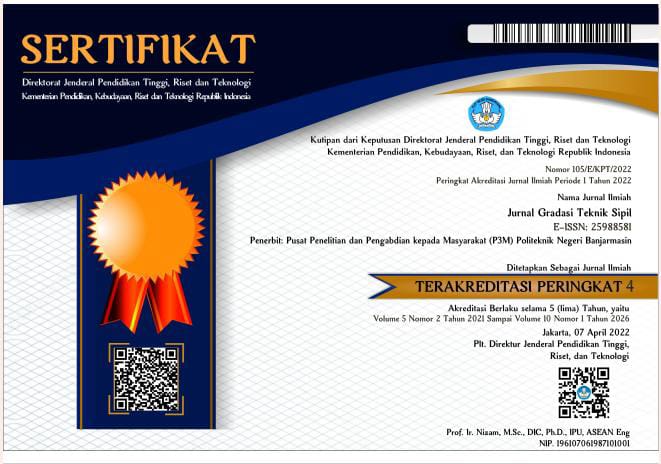Analisis Perbandingan Biaya Penggunaan Perancah Kayu Galam Dan Perancah Besi (Scaffolding)
DOI:
https://doi.org/10.31961/gradasi.v2i1.512Keywords:
galam wood scaffolding, iron scaffolding, Budget Planning (RAB), Rental Price, Purchase PriceAbstract
A scaffolding is a construction helper on building construction work. The scaffolding is made when the building work occupies a height of more than 2 meters and can not be reached by the workers. Because of the availability of galam wood in Banjarmasinis increasingly rare, thus the search for alternative material for scaffolding that is more durable, easier to get and can be used repeatedly is necessary to conduct. One of them is iron scaffolding. This research calculated and compared the cost of using galam wood scaffolding and iron scaffolding in the purchase price and rental price to find out which type of scaffolding is more economical to use.
The method used in this research was descriptive method and comparative method . The locations of data retrieval were on the construction of Central Bureau of Statistics Office (BPS) South Kalimantan Province on Jl Trikora Banjarbaru and 3-storey building on Jl. Banua Anyar Banjarmasin.
Based on the calculation in the area of 1m2 the cost of galam wood scaffolding work of Rp. 147,057,81, -, the iron scaffolding work in rental price of Rp. 201,033,81 and the cost of iron scaffolding in the purchase price of Rp. 2,214,161,06 obtained. These results showed that the cost of galam wood scaffolding work 26.85% cheaper than the iron scaffolding in the rental price and 15 times the cost of iron scaffolding in the purchase price.
Keywords Galam Wood Scaffolding, Iron Scaffolding, Budget Planning (RAB), Rental Price, Purchase Price
Downloads
References
Astina, I Nyoman, 2015, ‘Value Engineering antara Perancah Konvensional dengan Scaffolding pada Proyek Konstruksi’, Explorasi Jurnal Teknik Sipil Untag Surabaya, Vol.8, No. 1 hh. 49-62.
Heinz, Frick dan Pujo. L Setiawan, 2007, Ilmu Konstruksi Struktur Bangunan. Seri Konstruksi Arsitektur 4, Kanisius, Yogyakarta.
Mukomoko, J. A., 1987 , Dasar Penyusunan Anggaran Biaya Bangunan.Gaya Media Pratama, Jakarta
Ratnasari, Yudit H., 2015, Efisiensi Penggunaan Perancah Besi dan Perancah Bambu pada Pembangunan Gedung SKPD I Tipe A, Skripsi, Fakultas Teknik Universitas Gorontalo, Gorontalo.
Sarito, Trimanto, 1996, Petunjuk Kerja Acuan dan Perancah 1, Pusat Pengembangan Pendidikan Politeknik, Bandung.
SNI, 2008, Analisa Biaya Konstruksi, Badan Standardisasi Nasional (BSN).
Soedrajat, S.A.,1994, Anggaran Biaya Pelaksanaan ( Analisa Modern),Nova, Bandung.
Sumargo, Ario Raja Nata, 2006, Keruntuhan Perancah Scaffolding Saat Pelaksanaan Pengecoran, Media Komunikasi Teknik Sipil Volume 14 No. 1 Edisi XXXIV Pebruari, Politeknik Negeri Bandung, Bandung.
Suparno, 2012, ‘Kajian Pemilihan Jenis Bahan Perancah Beton pada Pembangunan Gedung Bertingkat’, Wahana Jurnal Teknik Sipil Politeknik Negeri Semarang,Vol. 17, No. 1, hh. 32-40.
Downloads
Published
Issue
Section
License
- Hak publikasi atas semua materi naskah jurnal yang diterbitkan/dipublikasikan dalam Jurnal Teknik Sipil ini dipegang oleh Dewan Redaksi dengan sepengetahuan penulis (hak cipta tetap dimiliki penulis).
- Ketentuan legal formal untuk akses artikel digital jurnal elektronik ini tunduk pada ketentuan lisensi Creative Commons Attribution-ShareAlike (CC BY-SA), yang berarti Jurnal Teknik Sipil berhak menyimpan, mengalih media/format-kan, mengelola dalam bentuk pangkalan data (database), merawat, dan mempublikasikan artikel tanpa meminta ijin dari Penulis selama tetap mencantumkan nama Penulis sebagai pemilik Hak Cipta.
- Naskah yang diterbitkan/dipublikasikan secara cetak dan elektronik bersifat open access untuk tujuan pendidikan, penelitian, dan perpustakaan. Selain tujuan tersebut, dewan redaksi tidak bertanggung jawab atas pelanggaran terhadap hukum hak cipta.








